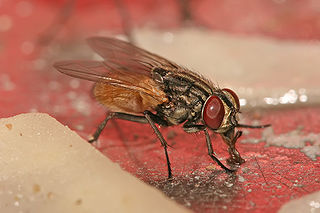Genera
- Achanthiptera Rondani, 1856
- Atherigona Rondani, 1856 [3]
| Atherigoninae | |
|---|---|
| Scientific classification | |
| Kingdom: | |
| Phylum: | |
| Class: | |
| Order: | |
| Family: | |
| Subfamily: | Atherigoninae Fan, 1965 |
The subfamily Atherigoninae is within the Diptera family Muscidae. [1] [2]

Helina is a very large genus from the fly family Muscidae.

Within the taxonomy of biology, the subfamily Muscinae includes two of the more familiar genera within the Muscidae family; Musca and Stomoxys.

Stomoxys is a genus of flies in the family Muscidae. The genus is unusual among the Muscidae in that it includes species that are bloodsucking ectoparasites of mammals. The best-known species is Stomoxys calcitrans, most commonly known as the stable fly.

Muscini is a Tribe of flies from the family Muscidae.

Phaoniini is a tribe in the fly family Muscidae. It contains the largest Muscid genus Phaonia.

The Mydaeinae are a subfamily of true flies, belonging to the family Muscidae.

Azeliini is a tribe of flies from the family Muscidae.

Stomoxyini is a tribe of flies from the family Muscidae.

The subfamily Phaoniinae is within the Diptera family Muscidae. All species are in the tribe Phaoniini.

Coenosiini is a tribe of flies from the family Muscidae.

Thricops is a genus of true flies of the family Muscidae.

Coenosia is a very large genus of true flies of the family Muscidae.

Haematobia is a genus of biting true flies of the family Muscidae.

Mydaea is a large genus from the fly family Muscidae.

Lispocephala is a very large genus of true flies of the family Muscidae.

Phaonia incana is a fly from the family Muscidae. It is found in the Palearctic.

Spilogona aerea is a fly from the family Muscidae. It is found in the Palearctic.

Lispe pygmaea is a fly from the family Muscidae. It is found in the Palearctic.

Lispe tentaculata is a fly from the family Muscidae. It is found in the Palearctic.

Azelia is a genus of flies belonging to the family Muscidae.